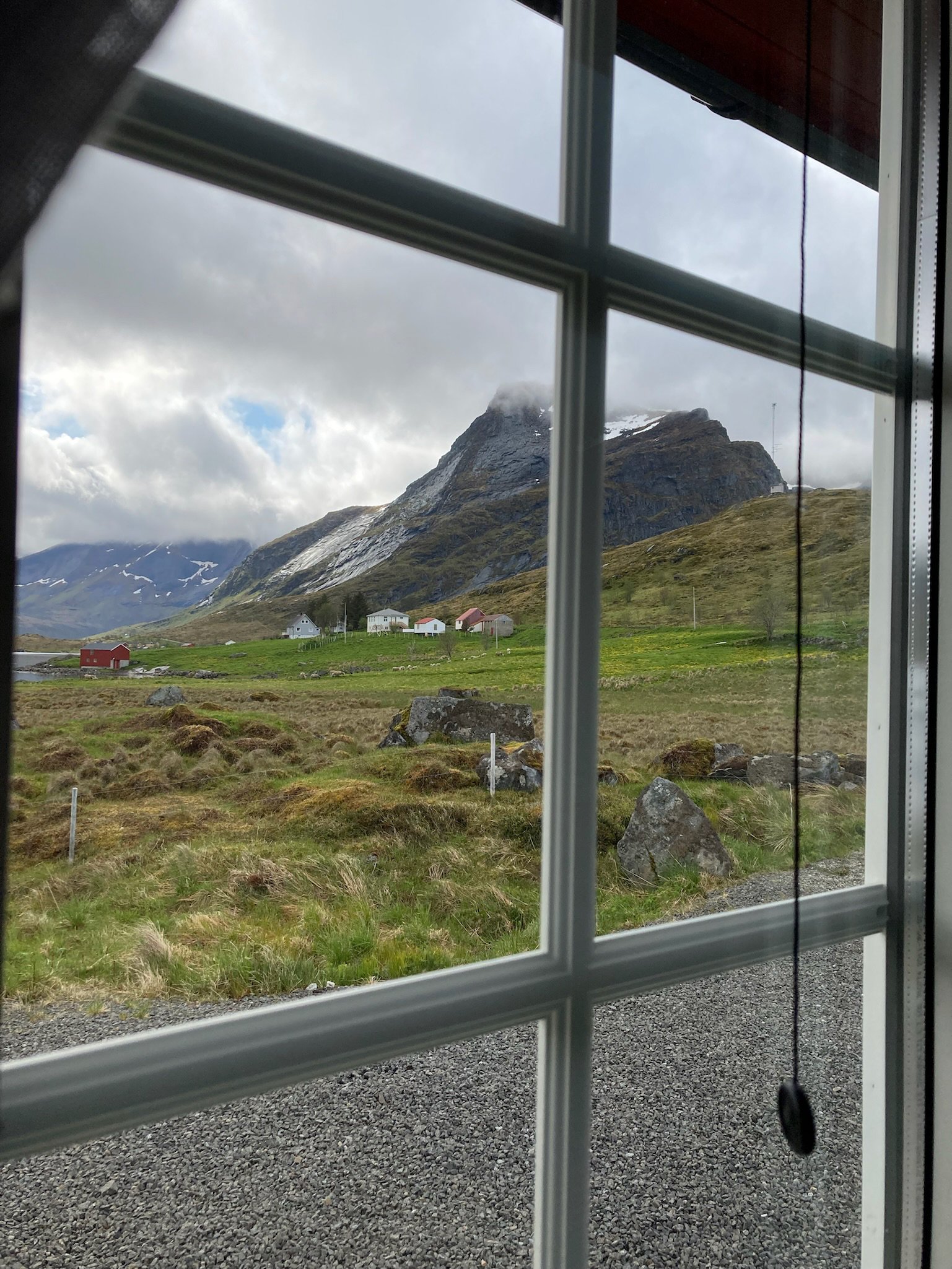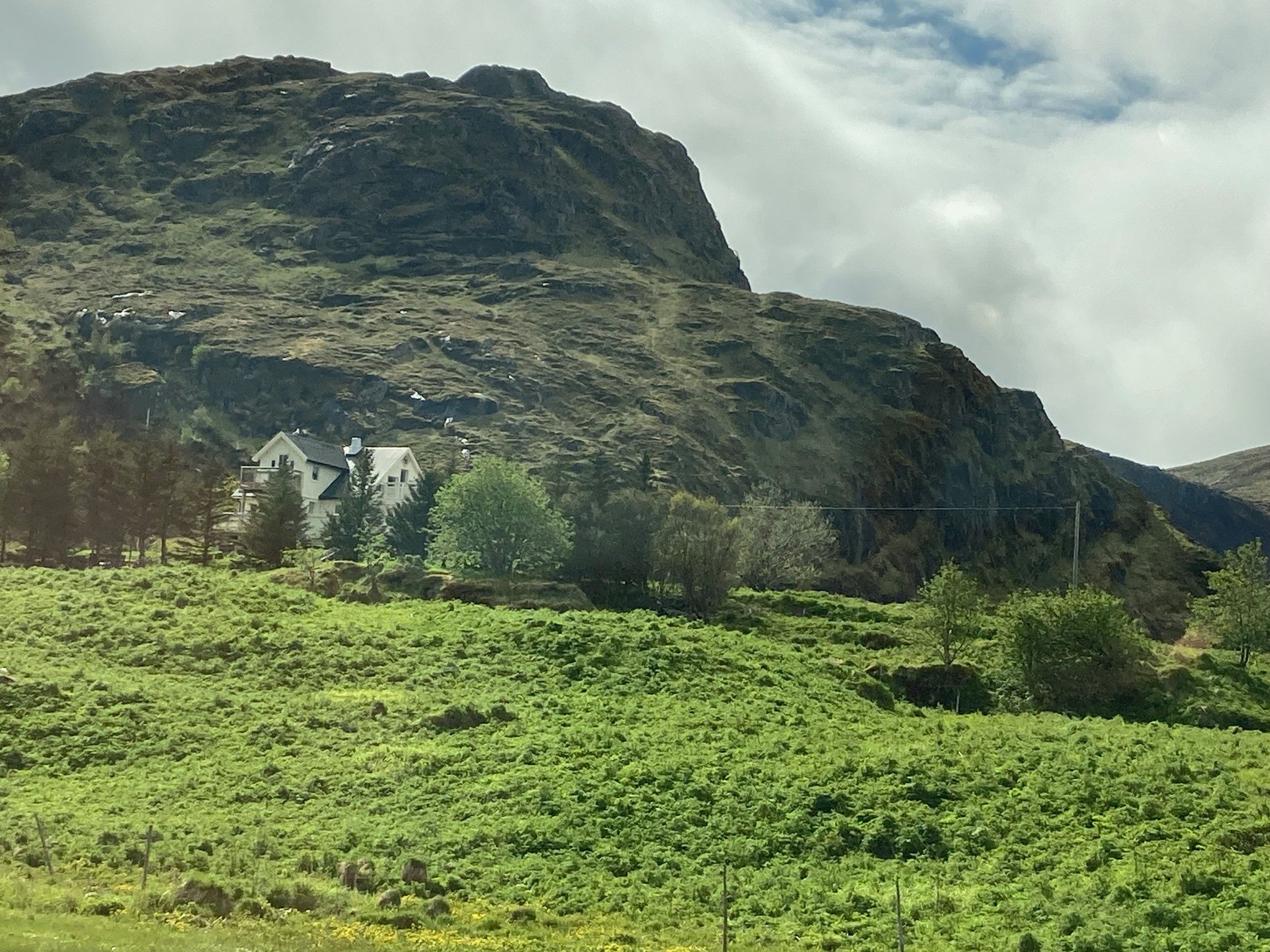
Lofoten Islands
A Place Like No Other
After hiking Nigardsbreen glacier we spent another night at Sogndal. We devoted the next day to travel. We drove back to Bergen and flew north to the city of Bodø. Bodø (pronounced Buddha) is on the Norwegian west coast located just north of the Article circle. Bodø is Northern Norway’s second largest city with of population of 41,215 (2018). For most tourists it is a gateway city to the Lofoten Islands by ferry.
Approaching Moskenesøya island of the Lofoten Islands, Norway
Lofoten Islands
The Lofoten Islands are an archipelago of mountain peak islands jutting out of the North Atlantic about 70 miles west of the Norwegian mainland. The dark barren rock massifs rise almost vertically from the water in some places. The inland side of the peaks descend just as abruptly to rich grasslands and cultivated farms. Despite its extreme northern latitude ocean currents moderate island temperatures especially during the long winter season. When we arrived in early June snow was still hanging onto many low peaks but roads were completely clear. Lofoten greeted us on our first day with overcast skies, strong breeze and afternoon temperatures in the mid 40 degrees F.
The islands are located at the 68th and 69th parallels north of the Arctic Circle in North Norway. The entire length of the main islands is about 70 miles or 110 kilometers. The island group comprises the southern end of the Lofoten-Vesterålen archipelago and includes five main islands of
Austvågøya,
Gimsøya,
Vestvågøya,
Flakstadøya,
Moskenesøya.
Additionally, there are many small islands and skerries (rocky islets and reefs). The total length of the archipelago is about 110 miles (175 km). A broad and deep fjord, the Vesterålsfjorden, lies between Lofoten and the mainland. The islands, composed of volcanic rocks (gneiss and granite), are the highly eroded tops of a partially submerged mountain range.
The most southern island called Moskensøya is where we spent most of our time in Lofoten.
Arriving at Lofoten
We rented a car in Bodø and spent a night there. The next morning we drove a short distance to the ferry landing and waited for the 11:00 AM ship to take us to the islands.
Bodø harbor as seen from the ferry.
The comfortable seating area and ocean views made the 3.5 hour journey enjoyable. We ordered hot food cooked on board. Though the front of the ship was not open to the public, the aft provided a large area to walk a bit and enjoy the views.
The author checking out the ship before we get underway.
The ferry route from Bodø to Moskenes Ferryport.
Exiting ferry and driving onto Lofoten.
A cozy cabin on the lake
We arranged for a five night stay at a comfortable and well-appointed AirBnB on Moskenesøya. The home nestled between two pastures and situated on a lake had two bedrooms, one bath, a full kitchen and fantastic views.
Once on the island we drove to our new home for the next four days.
This photo almost looks like it could be an advertisement for a car.
Views in all directions provided dramatic scenery.
Rainbows everywhere. No leprechauns at the end of the rainbow, only trolls.
This is probably as low as the sun got during our stay on Lofoten.
At night we opened the window for a bit of cool fresh air and the tranquil sounds of baying sheep.
Lazy summer showers . . . Uh, well, I’m running out of things to say for these captions.
Time for a hike
We attempted a hike to a mountain peak called Ryten that overlooks Kvalvila beach. However, with a late start and route more challenging than some of our fitness levels, we decided to just go to the top of the first peak and turn around. No problem. What we saw was worth the effort.
The hike began on someone’s farm. We paid for parking and set off across flat farmland and up a long gentle slope.
We tread over wooden boards to protect tender vegetation.
Take stock of your fish
Any visit to Lofoten wouldn’t be complete without mentioning the fishing industry.
You’ll be driving along any road on Lofoten and suddenly encounter a strange sight. From racks of wooden polls are hanging fish or fish heads drying in the sun. These are called "stock fish”. The web site, Seafood from Norway explains it best.
“Ever since the Viking age, Norwegians have dried fish outdoors in the fresh ocean wind to make stockfish. It is a specialty made almost exclusively in the North of Norway, and creating delicious stockfish requires the very best raw materials. Our stockfish comes mainly from the prime seasonal Arctic cod called skrei or the Norwegian Arctic cod, caught above the Arctic circle where the conditions are perfect for drying the fish. ”
Look closely to see people on the long gently sloping trail. The North Atlantic is in the distance.
The land is protected from foot traffic until you get to the side of the mountain.
The following images require no captions or explanations. They speak for themselves.
You would think that in early June, even above the arctic circle, the fish would smell awful. Not at all. Only when you get right up to it can you smell the aroma of dead fish. Perhaps they are at the end of their drying season.
I’ll close out this section with more notable images from Lofoten.
Final Thoughts on Norway
I have mixed feeling on the itinerary I created. In retrospect I would have haven chose to visit fewer places and instead planned more activities. On the other hand, traveling within a foreign country is an activity in itself.
Regarding the people of Norway; they were all friendly and helpful. Granted most people we met were in the hospitality industry. Reflecting on the turbulence of American life, right or wrong, I got the impression that modern Norwegians are kindler, gentler people who live a slower paced life than most of their American counterparts. Being a tourist, it’s hard to tell. I imagine you have to live and work in a place to get a feel for it.
One thing I will call Norway out on is pay toilets. Yes, you have to pay to use the restroom in shopping malls, train stations and parks. For such a progressive, socialist democratic state, pay bathrooms are really regressive.
The photo at right is the pay mechanism for a toilet facility in a really nice park in Oslo. As you can see, there are no options for paper or coin currency, only electronic payment. Norway is a cashless society. That’s a second mark in the minus column. Everything a citizen or visitor does is tracked or traceable by government in a cashless country. I wonder what other freedoms Americans take for granted that are completely unheard of in Norway and other European countries. Conversely, what freedoms they may have and we do not.
Driving in Norway was mostly a pleasant experience. Most roads and highways were not overcrowded. Highway signs were clearly marked. The only minus is Norway’s infamous narrow roads. We visited during the shoulder season, so traffic snarls were non-existent.
The long and winding road.
Pay toilets. Max Time is 15 minutes. I wonder how that is enforced.
Pay toilets for males and females only.
I noticed a conspicuous absence of first responders, police, fire and other medical/rescue vehicles on the highways. While in Lofoten, I did see a fire station near our AirBandB. Seems like sparse first responders along with narrow roads may hinder emergency response times.
If I were to return to Norway, I would return in winter and restrict travel to just Lofoten. From the photos I’ve seen winter Lofoten is even more beautiful. Activities like hiking are more restrictive. Winter Lofoten is definitely a different experience altogether.





































